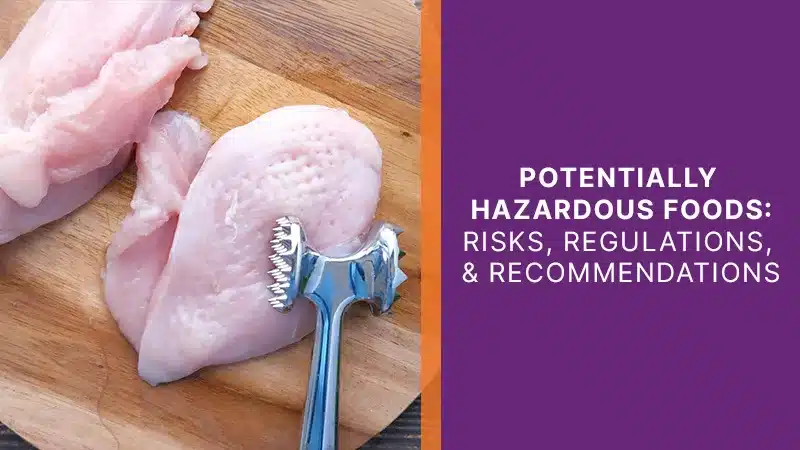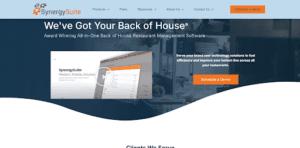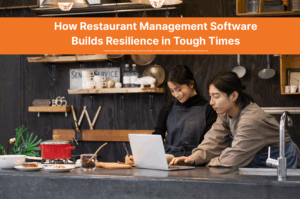Every meal has the potential to nourish our bodies. Unfortunately, every meal also has the potential to nourish pathogenic microorganism growth if mishandled. Properly handling PHFs (potentially hazardous foods) is essential to prevent foodborne illnesses.
Potentially hazardous foods are not just a concern for food scientists; they impact our daily lives and well-being. Understanding what these foods are is essential for both safety and health.
In this age of globalization, where diverse foods are readily available, knowing how to identify and handle potentially hazardous foods is crucial. Improper storage and preparation can create breeding grounds for harmful bacteria, putting public health at risk.
This article delves into the risks associated with potentially hazardous foods, the regulations governing their safety, and practical recommendations for consumers and food handlers alike. By exploring these topics, we can foster a more informed approach to food safety in our communities.
What are Potentially Hazardous Foods?
Potentially Hazardous Foods (PHFs or time/temperature control for safety foods) are foods that need strict time-temperature control to minimize the risk of harmful bacteria and toxin formation.
PHFs are found in various kinds of food commodities. These foods typically contain moisture with water activity above 0.85, are rich in protein, and have a pH level ranging from 4.6 to 7.5. Examples of PHFs include raw and cooked meats, milk products, other dairy products, eggs, seafood (excluding live seafood), and prepared fruits and vegetables. Virtually any kind of raw or half-cooked foods are potential PHFs.
The U.S. Food and Drug Administration now refers to PHFs as time/temperature control for safety (TCS) food. This highlights their specific requirements to limit microbial growth, which could lead to foodborne illnesses such as Staphylococcal food poisoning.
PHFs include both meats and plant-derived food. Common foods like cooked rice, pasta, sandwiches, and salads with PHF ingredients also need careful handling and storage.
Key factors in maintaining PHF safety revolve around controlling time and temperature. Proper handling ensures that these foods do not support pathogenic microorganism growth, preventing contaminations and ensuring safe food consumption.
These precautions help protect individuals from foodborne illnesses and related complications like flu-like symptoms.
| PHFs Examples | Safety Measures Required |
|---|---|
| Raw and cooked meat products | Time-temperature control |
| Dairy products | Maintain at safe temperatures |
| Egg products | Proper storage practices |
| Non-live Seafood (both salt and freshwater fish) | Limit the risk of microbial growth |
| Prepared fruits/vegetables | Careful handling |
How to Identify Potentially Hazardous Foods
When you think of hazardous, you might think of puffer fish with their deadly poison but virtually any kind of seafood can be wellsprings of food poisoning. The same goes for other categories of food.
It’s important to be mindful of your restaurant’s fresh, refrigerated, and frozen foods. Identifying Potentially Hazardous Foods (PHFs) is essential for ensuring food safety.
PHFs are characterized by their ability to support the growth of pathogenic microorganisms and the potential for toxin formation. Key factors for identifying PHFs include moisture content, nutrient richness, and pH level. Foods with a water activity above 0.85, adequate protein, and a pH range between 4.6 and 7.5 are typically considered PHFs.
Common examples of PHFs are raw and cooked meats, poultry, eggs, dairy products, and seafood, except live varieties. Prepared fruits, vegetables, cooked rice, fresh and cooked pasta, and dishes like soups and stews that use these ingredients also fall under this category.
The United States Food and Drug Administration has updated the terminology to Time/Temperature Control for Safety (TCS) foods, emphasizing the importance of managing time and temperature to prevent the growth of harmful bacteria. Proper storage and handling are critical to avoid foodborne illnesses associated with PHFs.
Here’s a quick list of PHFs:
- Raw and cooked meats
- Poultry products
- Raw fish and other Seafood (excluding live varieties)
- Dairy products
- Cooked rice and pasta
- Prepared fruits and vegetables
The Importance of Properly Handling Potentially Hazardous Foods
Customers suddenly experience flu-like symptoms. Nausea, cramps, and other common symptoms of consuming pathogenic bacteria. Runs to the bathroom or exit, bad reviews and word of mouth, and inspections from the health department.
These are elements of a common nightmare among restauranteurs: the ingestion of harmful microorganisms and bacterial toxins resulting from the contamination of food served at the restaurant.
Properly handling Potentially Hazardous Foods (PHFs) is crucial to preventing foodborne illnesses.
PHFs require specific time and temperature control to minimize the growth of pathogenic microorganisms and prevent toxin formation. Keeping these foods hot at 140 degrees Fahrenheit or above or cold at 41 degrees Fahrenheit or lower is essential. If left in the danger zone (70-125 degrees Fahrenheit) for over four hours, PHFs can become unsafe due to the rapid growth of harmful bacteria.
Storage
Storing PHFs correctly is vital to maintain their safety.
Cold items should be stored below 41°F, while hot items must be held above 135°F. Proper storage equipment is necessary during events to maintain these temperatures, reducing the risk of microbial growth. Minimizing the time PHFs spend in the temperature danger zone (5°C and 60°C) is crucial. Always ensure food is within its shelf life, and dispose of any remaining food after events to prevent contamination.
Safe Handling and Preparation
Contamination of foods that are not themselves PHFs can be just as dangerous as consuming the harmful microorganism directly. For that reason, food handlers must possess the skills and knowledge to manage PHFs safely, as mishandling can lead to food poisoning outbreaks.
PHFs should be kept below 41°F for cold foods and above 135°F for hot foods. A food thermometer is essential to confirm that the foods remain within safe temperatures. Food handlers should not prepare food when experiencing gastrointestinal symptoms like vomiting or diarrhea, and they should avoid food preparation 2-3 days after symptoms subside.
Personal Hygiene & Sanitation
Maintaining high personal hygiene standards is crucial in preventing food contamination.
Regular hand washing, wearing clean clothing, avoiding contaminated water and surfaces, and tying back long hair are mandatory practices for food handlers. Minimal jewelry should be worn to avoid contaminating PHFs.
Legal obligations require food businesses to implement safe handling and hygiene practices to protect food from contamination. Any lapse in personal hygiene and sanitation may lead to increased foodborne illness risks, necessitating corrective actions during inspections.
Storage
Potentially Hazardous Foods (PHF) require careful storage to ensure food safety and prevent microbial growth. Cold PHFs must be stored below 41°F, while hot PHFs should be kept above 135°F.
The more time outside of these boundaries the more incubation time for foodborne pathogens. These temperature controls are crucial to avoid the development of harmful bacteria and toxin formation.
Hot or cold holding equipment may be necessary during events or catering situations to maintain the appropriate temperatures. It is important to minimize the time PHFs spend in the temperature danger zone, which ranges from 41°F to 135°F (5°C to 60°C), as this is where pathogenic microorganisms thrive and could lead to foodborne illnesses.
To further ensure food safety, use ingredients within their shelf life and dispose of any leftovers at the end of an event. This practice prevents contamination and reduces the risk of foodborne illnesses, helping ensure that the food supply remains safe and reliable for consumption.
Use Technology to Manage Hazardous and Non-hazardous Food
Efficient management of hazardous and non-hazardous foods ensures food safety and prevents foodborne illnesses.
SynergySuite offers a comprehensive suite of tools and partners designed to streamline this process. Key features of our award-winning software include checklist creation for routine inspections, and food safety tools to ensure proper handling procedures, and managing inventory to keep a close eye on both perishable and non-perishable items.
Utilizing technology through desktop and mobile platforms like SynergySuite can greatly assist food handlers in monitoring conditions prone to hazardous food issues, such as the formation of toxins and the growth of harmful bacteria.
This proactive approach helps control for safety and ensures that food products, including dairy, hot foods, or raw items, remain safe for consumption. The software’s inventory management capabilities are particularly useful for managing food supply effectively.
Don’t wait for your patrons to show foodborne illness symptoms or other health issues before you start taking food safety seriously.
By integrating technology into food management practices, businesses can reduce the risk of foodborne illnesses such as Staphylococcal food poisoning while maintaining safe food standards and efficiently managing food commodities from different sources.
Contact us today to set up a free, personalized demo.






